
the Plantation Pipeline transports gasoline and other refined petroleum products from the Gulf Coast to Northern Virginia, while the Colonial Pipeline (built later) goes further north
Source: Argus Colonial Pipeline line space assessments

the Plantation Pipeline transports gasoline and other refined petroleum products from the Gulf Coast to Northern Virginia, while the Colonial Pipeline (built later) goes further north
Source: Argus Colonial Pipeline line space assessments
All refined petroleum distillate products used in Virginia - gasoline, diesel, home heating fuel, jet fuel - comes from refineries on the Gulf Coast or are imported through tankers coming to Norfolk and Newport News. No crude (unrefined) oil is shipped by major "trunk" pipelines through Virginia, but unrefined crude oil has been transported by rail to a terminal at Yorktown and then caried by tankers/barges to refineries in or near New Jersey.
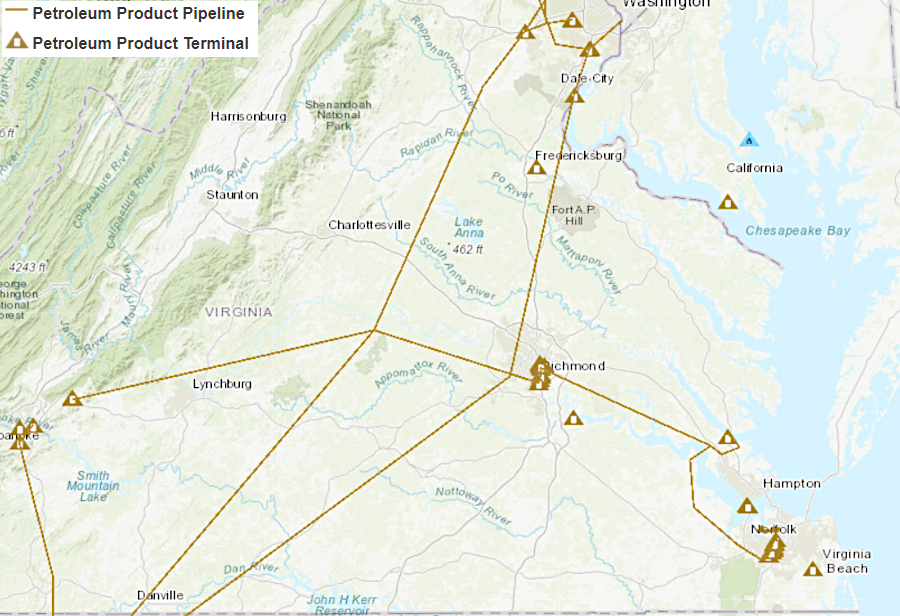
Virginia has three major pipelines for refined petroleum products, two going north-south and one going east-west
Source: Energy Information Administration, U.S. Energy Mapping System
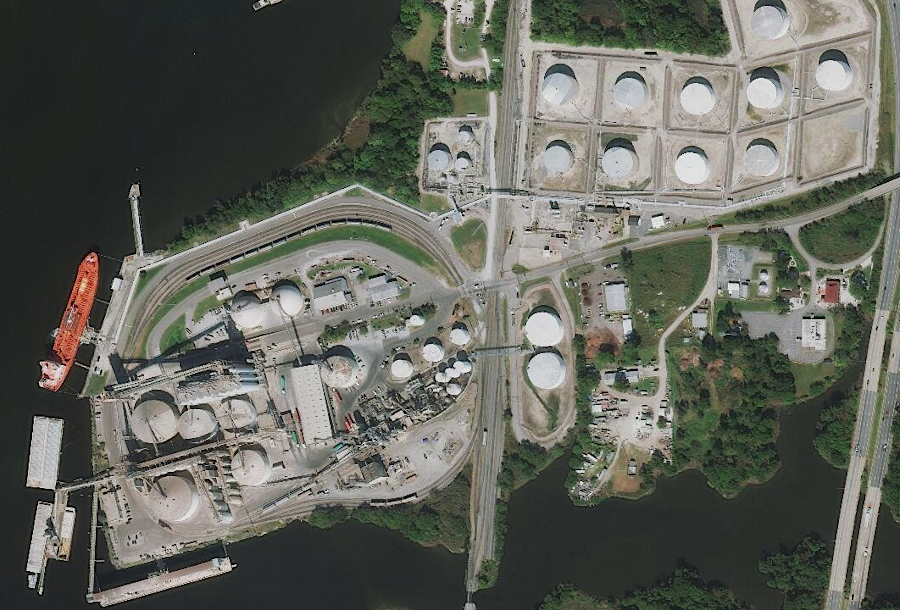
the storage terminal on Barnes Road in the City of Chesapeake can be supplied by tanker, and is connected to the Colonial Pipeline by a spur to Hampton Roads
Source: ESRI, ArcGIS Online
About 1,000 miles of trunk pipeline ship refined liquids (gasoline, kerosene, jet fuel...) to customers in Virginia. The refined petroleum products move through the pipeline at 3-8 miles per hour, so oil could be pumped from below the floor of the Gulf of Mexico, processed in a refinery, and sold in Virginia within a month of extraction.1
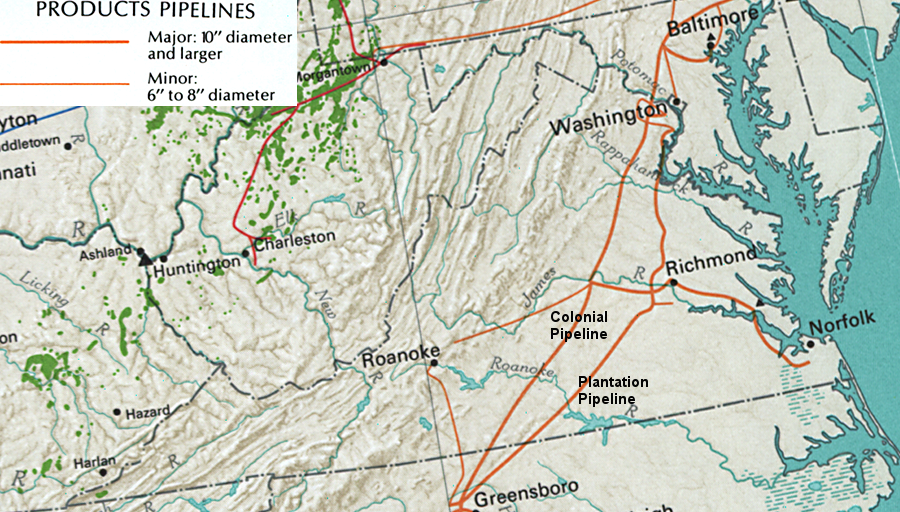
as shown in this 1970 map, the Colonial Pipeline carries refined petroleum products such as gasoline and jet fuel to Lynchburg while the Plantation Pipeline goes directly to Richmond
Source: Library of Congress, "The national atlas of the United States of America," Crude Oil and Products Pipelines
The Colonial Pipeline, one of Virginia's two major petroleum product pipelines, goes east of the Blue Ridge. It carries refined petroleum products from the North Carolina border through Lynchburg, and continues northeast through Northern Virginia. The Colonial Pipeline terminates at a terminal in Linden, New Jersey, from which it supplies the New York City area.
The Plantation Pipeline crosses the Virginia-North Carolina border at a point further east of the Colonial Pipeline, and carries petroleum products directly to Richmond. It continues north, parallel to the I-95 corridor, and terminates in Northern Virginia at Newington.
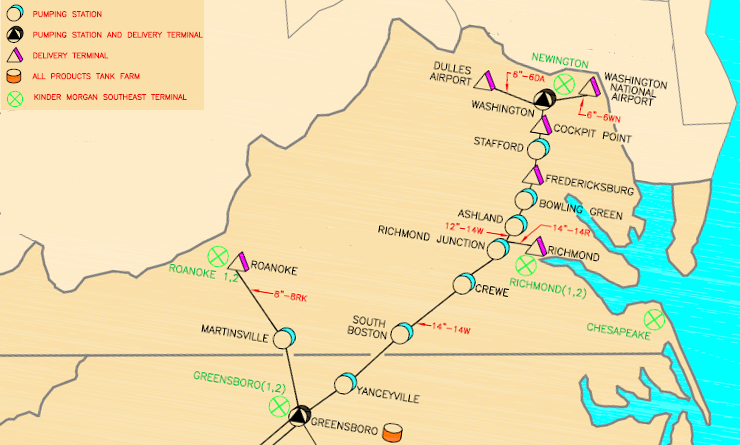
Plantation Pipeline was built in 1942 to Greensboro, North Carolina, then extended to Northern Virginia in 1964
Source: KinderMorgan, Southeast Region
Prior to World War II, tankers carried crude oil from the Gulf Coast to refineries in Philadelphia and New Jersey. In 1942, German U-boats began sinking the tankers off the coast of Virginia and North Carolina. Not enough oil could be transported by railroad in tank cars, so three pipelines were constructed to serve the East Coast.
The 24" diameter "Big Inch" and 20" diameter "Little Inch" pipelines were built from the Gulf Coast to Illinois, then east across Pennsylvania. The "Big Inch" and "Little Inch" pipelines did not cross Virginia.
The Plantation Pipeline, constructed by affiliates of Shell, Texaco, Chevron, and Exxon in 1942, pumped refined petroleum products from refineries in Louisiana to Greensboro, North Carolina. The pipeline carried diesel, gasoline, kerosene, and jet fuel - not crude oil. The Plantation Pipeline was extended from Greensboro to Richmond in 1943. In 1964, when the Colonial Pipeline was built to Linden, New Jersey, the Plantation Pipeline was extended to Alexandria.2
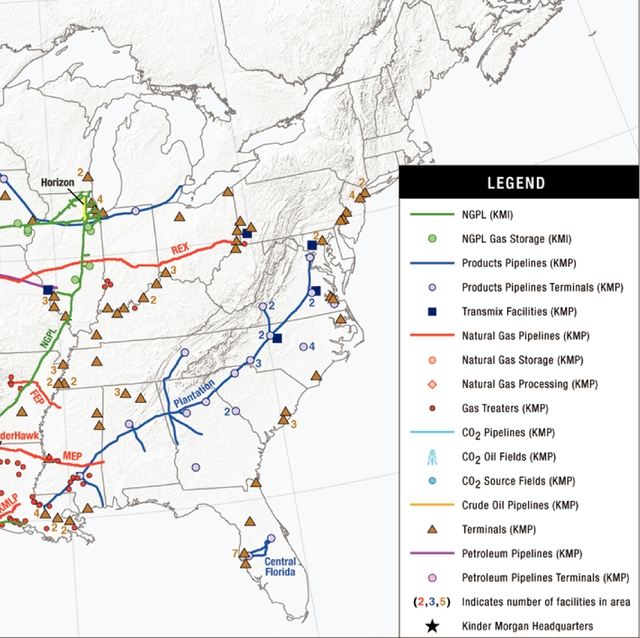
KinderMorgan's Plantation Pipeline stops in Northern Virginia
Source: Securities and Exchange Commission, Kindermorgan Prospectus (February 3, 2011)
The Plantation Pipeline now ends at the Newington fuel distribution terminal in Northern Virginia. Two spurs carry jet fuel to Reagan National Airport (DCA) and Dulles International Airport (IAD).
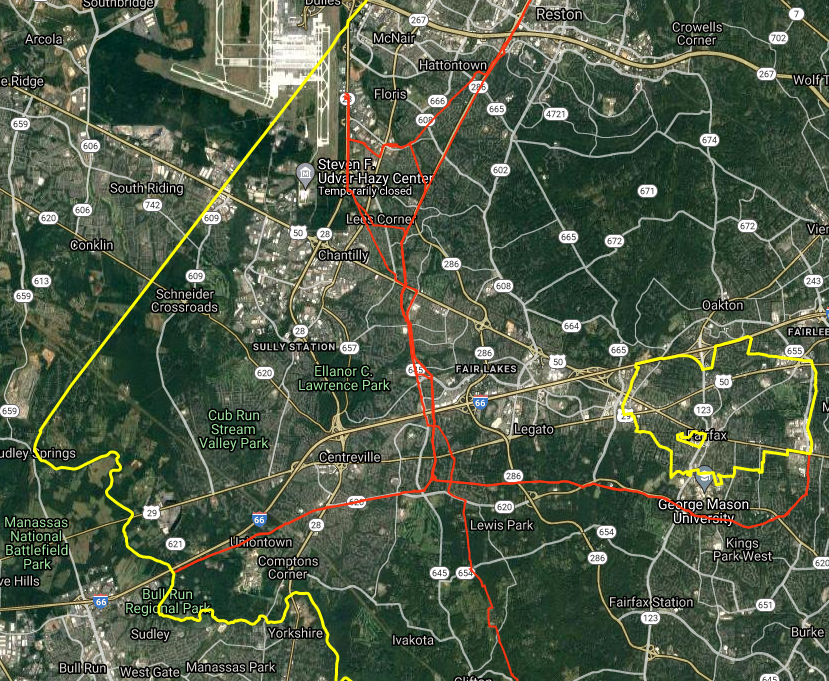
the Colonial Pipeline (red line) can deliver jet fuel to Dulles International Airport on the border of Fairfax and Loudoun counties (straight yellow line)
Source: National Pipeline Mapping System, Public Viewer
Plantation Pipeline can transport a batch of petroleum from Louisiana to Virginia in 20 days. Its transportation cost, just three cents/gallon, is more competitive than the alternative of shipping by barge, rail, or truck.
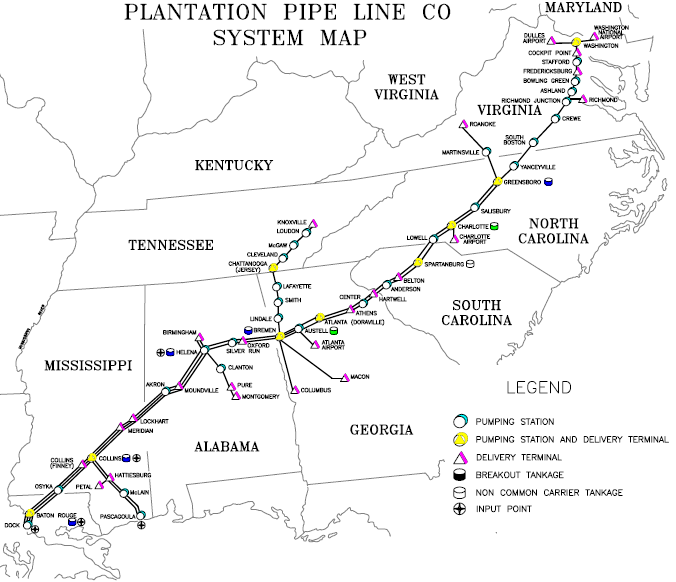
Plantation Pipeline system map
Source: Plantation Pipeline
In 2021, the Internal Revenue Service recorded 38 active fuel terminals in Virginia. At Newington, 15 different tanks can store 853,000 barrels of refined petroleum products. Gasoline is blended with various additives and ethanol at the Newington terminal, then trucked to gas stations and sold under different brand names.3
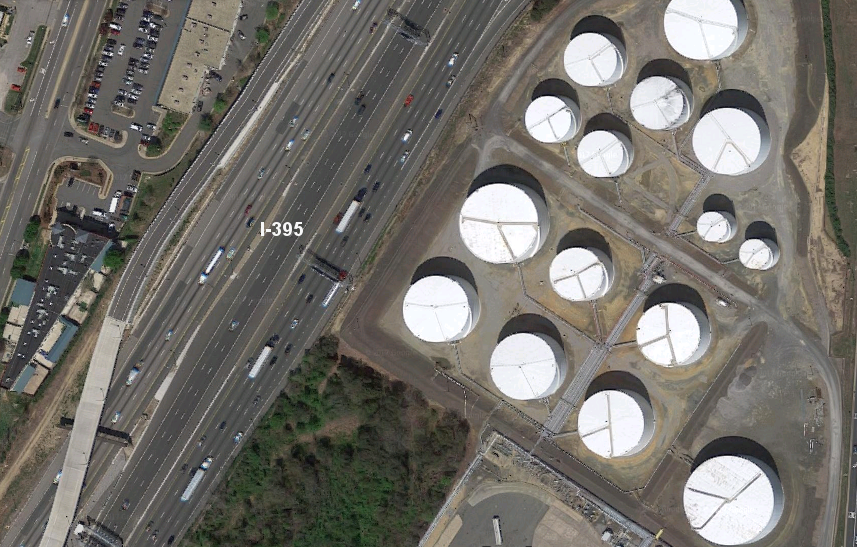
the Plantation Pipeline ends at Newington, with tank farms viewed by travelers on I-395
Source: Google Maps
After World War II, demand for petroleum products on the East Coast increased beyond the capacity of the Plantation Pipeline. In the 1960's, nine major oil companies combined to build a second pipeline from Houston, Texas to Linden, New Jersey. The Colonial Pipeline was constructed to provide an alternative channel to distribute petroleum products from refineries along the Gulf Coast to customers in the New York area.
The original plan was for eight oil companies to build a pipeline 22 inches in diameter to Baltimore. After Socony Mobil joined the consortium, a larger and longer pipeline was constructed in 1963-1964. It took 18 months to complete the 36-inch Colonial Pipeline to Greensboro, a 32-inch extension to Baltimore, and a 30-inch stretch to Linden, New Jersey. A parallel mainline was constructed through Virginia in the 1970's to expand the Colonial Pipeline capacity.
Stub lines to Roanoke and Chesapeake were constructed to serve population centers that were not located on the mainline route.
All petroleum products pumped north to Greensboro goes into tank storage at that North Carolina city. Batches of gasoline, diesel, jet fuel, and kerosene pumped to points further north were drawn from those tanks. Separating the northern and southern segments of the pipeline creates flexibility for Colonial Pipeline to assemble batches of products in different volumes than what was pumped up to Greensboro. Separating the pipeline segments also reduced the risk of a pressure wave propagating through the entire system and causing a leak.
Pumping stations force the refined fluids through the buried pipe at an average of 2.5 miles per hour. It requires about three weeks for a batch to travel through the entire pipeline, 1,600 miles from Houston to the New Jersey terminal. At the northern tip, distribution companies draw from the storage tanks and deliver to customers in the New York area.4
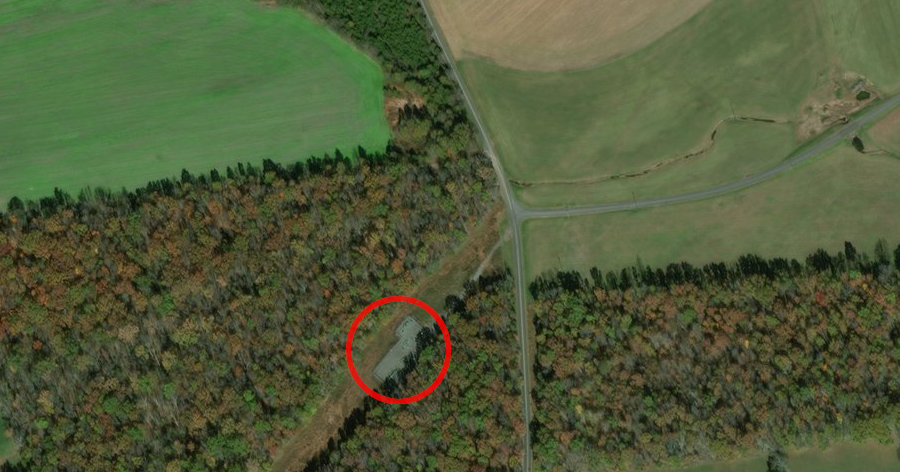
Colonial Pipeline has a pumping station just north of the Rapidan River to maintain pressure and move petroleum products further northeast to New Jersey
Source: ESRI, ArcGIS Online
A tank farm at Mitchell Junction in Cumberland County, just south of the James River, stores products pumped through the mainline until batches are sent towards Roanoke or Hampton Roads.
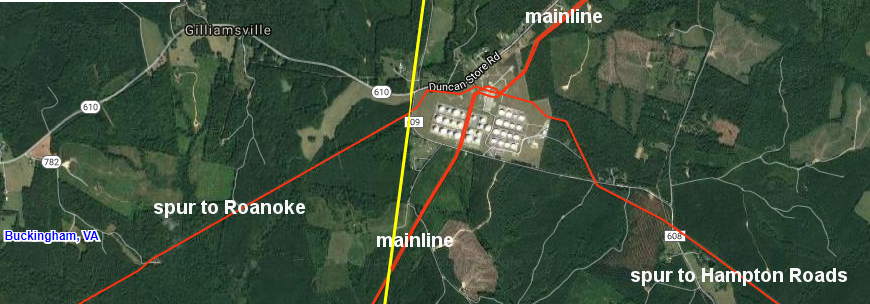
Colonial Pipeline built stub lines from Mitchell Junction to deliver petroleum products to Roanoke and Hampton Roads (yellow line is Buckingham/Campbell county boundary)
Source: National Pipeline Mapping System, Public Viewer
Hurricane Isabel in 2003 created brief fears of a gas shortage in Hampton Roads. Colonial Pipeline anticipated that rapid erosion from the rainfall could cause a break in the pipeline, which is buried only three-four feet deep, and closed the 150 mile spur to Hampton Roads. Inspections after the storm revealed no damage, but it took 3.5 days to pump a new supply of gasoline and other petroleum products from the main pipeline at Mitchell Junction in Cumberland County to the terminals at the end of the line.
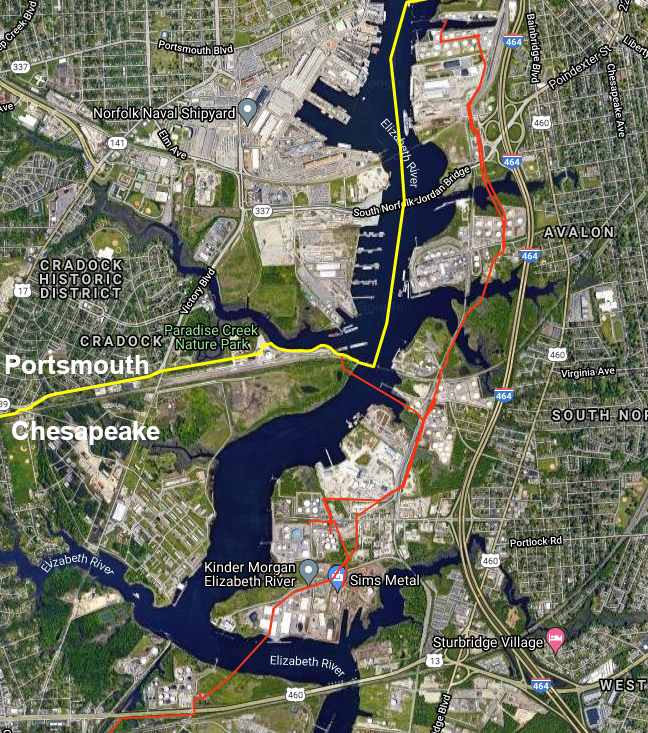
Colonial Pipeline spur to Hampton Roads (red line) serves multiple terminals on the Southern Branch of the Elizabeth River (yellow line is Portsmouth/Chesapeake city boundary)
Source: National Pipeline Mapping System, Public Viewer
In 2017, the Colonial Pipeline transported 100 million gallons daily of petroleum products from 26 refineries on the Gulf Coast as far as a terminal in Linden, New Jersey. When Hurricane Harvey devastated Houston that year, the pipeline shut down for a different reason than in Hurricane Isabel. Half of the refineries were located between Houston and Lake Charles, Louisiana. The heavy rainfall forced them to close, so there was no diesel, aviation fuel, or other distilled products to ship until the refineries restarted operations.5
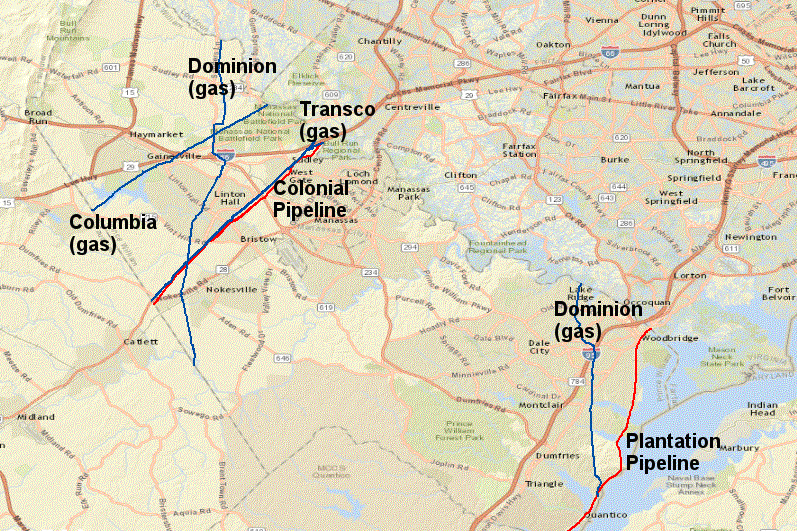
Colonial Pipeline and Plantation Pipeline carry gasoline and distillates through Prince William County (gas pipelines are displayed in blue)
Source: National Pipeline Mapping System, Public Viewer
The Colonial Pipeline crosses Virginia from the Tennessee border to the Potomac River with two major parallel trunklines. Line 1 carries different 38 different grades of gasoline. The other pipe carries 7 grades of kerosene and 16 grades of home heating oil and diesel fuel ("distillates" other than gasoline).6
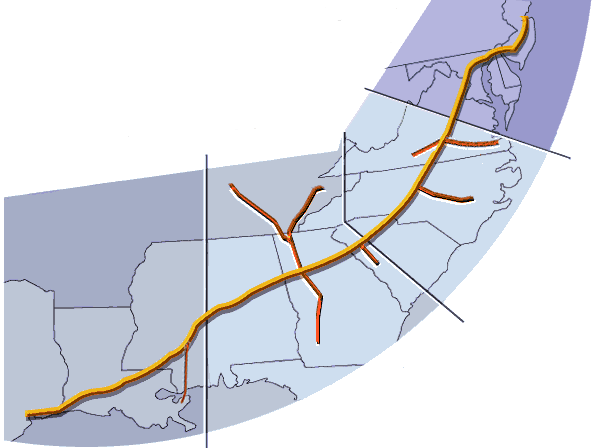
Colonial Pipeline carries gasoline and distillates from Texas to Linden, NJ
Source: Colonial Pipeline, System Map
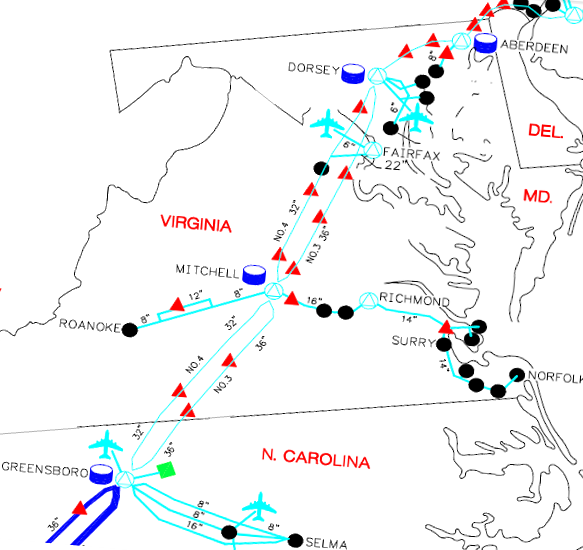
path of Colonial's No.3 and No.4 pipelines through Virginia, with connections to Roanoke, Richmond and Hampton Roads
Source: Colonial Pipeline Facility Map
Colonial Pipeline has an extension to Hampton Roads. That allows it to deliver gasoline, jet fuel, and other distillates to the Craney Island Fuel Terminal, the US Navy's largest fuel storage facility in the United States. In addition to the pipeline, Craney Island can receive refined oil products via tanker and barge deliveries.
The US Navy's Yorktown Fuel Terminal also has the capability to be supplied via tanker, but that facility relies mostly upon Colonial Pipeline deliveries. The military terminal redistributes petroleum products, primarily jet fuel, to military bases via barge and truck deliveries. A 2011 eastern extension of the Colonial Pipeline connected the Yorktown Fuel Terminal to the petroleum storage and distribution hub located at the site of the former Yorktown refinery.7
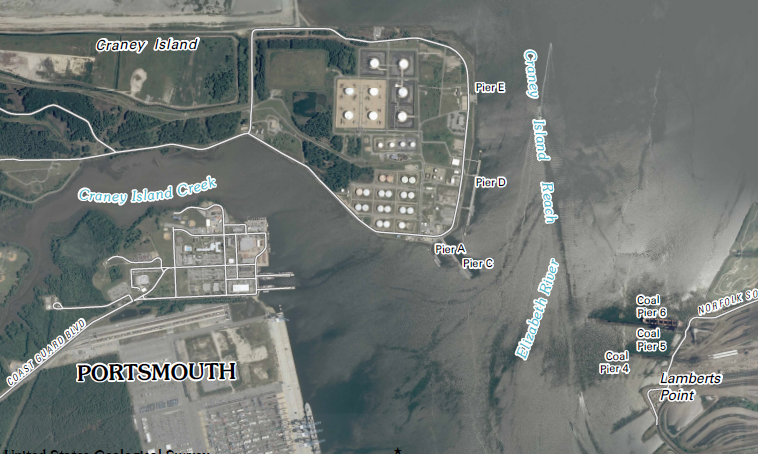
Craney Island Fuel Terminal, north of the APM Terminal and across the Elizabeth River from Norfolk Southern coal export facility at Lamberts Point
Source: US Geological Survey (USGS), Norfolk North 1:24,000 scale topo map (2011)
Colonial does not ship biodiesel in its pipelines through Virginia, even though a test in 2007 showed biodiesel transport from Texas to New York by pipeline cost $0.03/barrel vs. $0.15 to ship by truck.
The Fatty Acid Methyl Esters (FAME) in biodiesel could adhere to pipeline walls as the fuel is transported, then contaminate a later batch of jet fuel that is pumped through the same pipeline. Airlines are unwilling to use jet fuel with FAME contamination, since jet engine performance could be affected.8
In addition, hydrocarbon molecules are hydrophobic but biodiesel molecules are hydrophilic, so more water could be dissolved in biodiesel and increase corrosion/dirt in pipelines. However, in 2011 Colonial agreed to ship biodiesel through a pipeline in Georgia that does not transport jet fuel.9
When refined petroleum products are shipped in the trunk pipelines, batches of different products (such as regular vs. premium gasoline, or home heating oil vs. ultra low sulfur diesel) mix at the edge of each shipment. Products are normally transported without a physical separator between them, so some mixing will occur at the boundary of each batch in the pipe.
Batches of petroleum in the Plantation Pipeline can be as small as 15,000 barrels (630,000 gallons), but the minimum shipment size is 25,000 barrels if the product must be segregated from other batches. Pipeline operators schedule shipments about a month in advance, based on orders from customers who need different products delivered from refineries to storage terminals. Smaller distribution pipelines or trucks will carry the petroleum distillates to their final destination, such as gas stations, heating oil tanks at individual businesses/houses, or airports.
It is more efficient for pipelines to operate in "fungible" rather than "batch" mode. Operators schedule the pipeline's pumps and valves to gather the same grade of product from different producers in sequence, and then transport that identical refined product to different customers. As large volumes of a single product moves through the pipeline, customers at different locations remove their share.
The schedule guides how much of a particular product such as gasoline will be gathered and pumped north, before pipeline operators assemble volumes of different products and pump them in sequence.

the Plantation and Colonial pipelines transport different types of petroleum distillates, in discrete batches, from refineries on the Gulf Coast to terminals in Virginia
Source: presentation by Jaime Cerda based on Diego C. Cafaro's doctoral thesis, Oil Pipeline Logistics
A unique type of gasoline could be produced at a refinery and delivered in a single batch to a specific terminal somewhere along the pipeline, comparable to FedEx or UPS delivering a package ordered from Amazon to a single house. That option would be more expensive than the normal process of shipping generic gasoline through the pipeline to tank farms, then putting additives into it to create a different brand.
The premium gasoline sold at Exxon, Sunoco, or Sheetz stations is the same product inside the pipeline as it flows north from the Gulf Coast. Additives incorporated at the final terminal, just before delivery by truck to individual gas stations, make different brands somewhat distinct when sold at the pump.
Pipeline operators seek to ship different products in long cycles, pumping the same product for multiple days to minimize the mixing at the ends of different batches. A shipment of jet fuel in a pipeline will stay pure in the middle, but at either end of the batch the jet fuel will mix with whatever other product is being shipped. The blended product may be sold at the value of the lowest-quality component, "interface" or "transmix" of incompatible material may be pumped into a separate storage tank and reprocessed:10

typical product sequence and interfaces in a refined products pipeline, if distillates and gasoline are not shipped in separate pipelines
Source: Energy Information Administration, The Transition to Ultra-Low-Sulfur Diesel Fuel: Effects on Prices and Supply (Appendix C, Figure C-1)
Another factor to consider when shipping batches of product is storage capacity at the terminal. Each refined product must be stored in dedicated tanks. Cleaning a tank to store a different product, a necessary step to ensure purity and minimize contamination, is expensive. Storage capacity for kerosene, gasoline, and other products is evaluated by customers before determining what will ordered from the pipeline:11
Pipeline accidents can affect supply, human safety, and the environment. In 2016, a break in the Colonial Pipeline in Alabama forced the company to stop pumping new product from the refineries on the Gulf Coast. Supplies continued to flow north from the break, but gas prices climbed in Georgia and then North Carolina as the pipeline emptied.12

Colonial's two pipelines bracket Victory Elementary School in Prince William County, southwest of Manassas
Source: ESRI, ArcGIS Online
Colonial Pipeline operators in Atlanta responded incorrectly in March, 1980 when a pump station in Conowingo, Maryland shut down. The oil had been moving at 5 miles/hour, carrying 18,000 gallons/minute through Virginia, but the shutdown caused oil to back up and pressure to increase in the 32-inch pipeline south into Virginia.
Instead of triggering an orderly shutdown of pumping stations, operators tried to keep the pipeline in business by diverting some of that oil into the 22-inch branch pipeline going to the tank farm on Pickett Road in the City of Fairfax. Within two minutes, the main pipe burst in two places. The break at Manassas released 200,000 gallons of aviation-grade kerosene. Further south near Route 645 in Orange County, a batch of Number 2 home heating oil leaked into Mine Run, a tributary of the Rapidan River.13
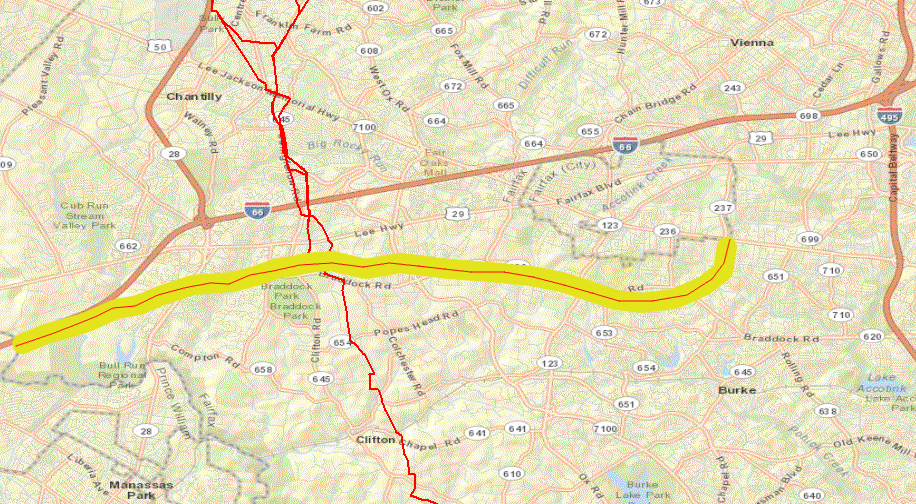
a 22-inch wide pipeline (red line with yellow border) transports petroleum products from the main Colonial Pipeline to the tank farm on Pickett Road, near the intersection with Route 236
Source: US Department of Transportation, National Pipeline Mapping System
The break in the Colonial Pipeline near Manassas caused kerosene to flow from the intersection of Route 234/Sudley Road to Bull Run and ultimately into the Occoquan Reservoir - the water supply for southern Fairfax County and eastern Prince William County. The Bull Run Marina was used as the primary staging area for the cleanup. Eleven Fairfax County firefighters suffered chemical burns after they placed flotation collars in Bull Run to intercept the kerosene, but the Fairfax County Water Authority plant on the Occoquan Reservoir was able to stay operational.14
It took 24 hours to discover the Rapidan River pipeline break, which released 60,000 gallons of home heating oil and caused a 31-mile oil slick down to the Fredericksburg water intake. The City of Fredericksburg had to shut down its drinking water plant, and Governor Dalton declared a state of emergency.
The city closed schools briefly, then banned students from taking showers at school when the system re-opened. The water crisis in Fredericksburg lasted 13 days, and at one point the city used a convoy of tanker trucks to carry uncontaminated water from a quarry until the leaked oil was no longer a problem at the Rappahannock River intake.15
The 1980 oil spill caused Fredericksburg to build a new system to isolate its water supply from the Rappahannock River. A 7,000-foot long pipeline in the Rappahannock Canal, plus gates at the junction of the canal and Rappahannock River, was expected to protect 10 days of water supply from future incidents that polluted the river. However, the $1.5 million project failed. Dye traces showed continued leaks from the river into the canal.16
Another spill in December 1989, this time of over 200,000 gallons of kerosene into the Rapidan River, again forced closure of the water system in Fredericksburg after the containment boom dam failed on New Year's Eve. The piece of pipe that cracked was apparently part of a shipment that had been loaded incorrectly on railroad cars when the Colonial Pipeline was first built in 1962-64, so hairline cracks developed and later caused pipe failures.
The 1980 and 1989 spills, together with continued frustration with Federal and state oversight of petroleum pipeline construction and operations, spurred Fredericksburg to abandon its direct use of Rappahannock River for drinking water. The city built a new drinking water reservoir on Motts Run to serve as the city's water source.17
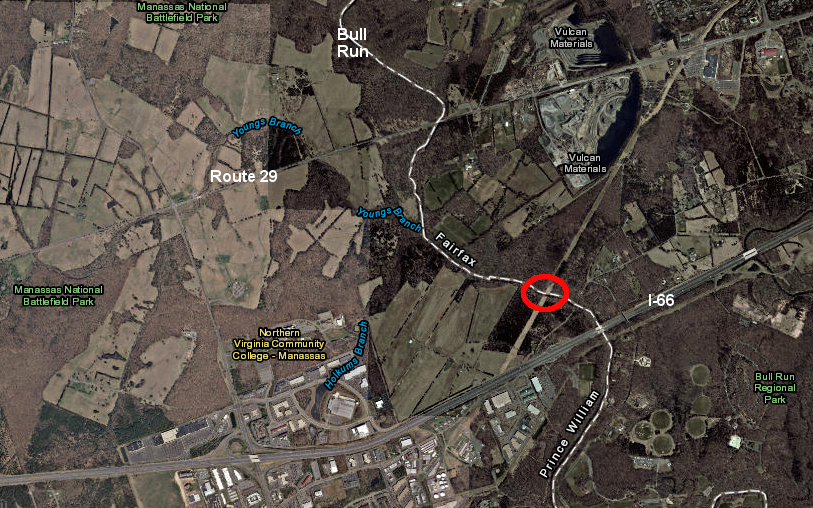
Colonial Pipeline crosses Bull Run north of I-66, and blocks Vulcan's quarry from further expansion to the east
Source: ESRI, ArcGIS Online
A 1993 break of the Colonial Pipeline in Fairfax County released 400,000 gallons of diesel oil into Sugarland Run. Fairfax County had to close its drinking water intake on the Potomac River for 11 days, while the oil was skimmed off for removal or washed downstream.
Federal agencies completed a Natural Resource Damage Assessment and required Colonial Pipeline to pay for restoration and enhancement of wildlife habitat along the Potomac River. Part of the mitigation effort included constructing a fish passage through Little Falls Dam and building a raised wetland boardwalk and interpretive signage at Dyke Marsh, downstream of Alexandria.18
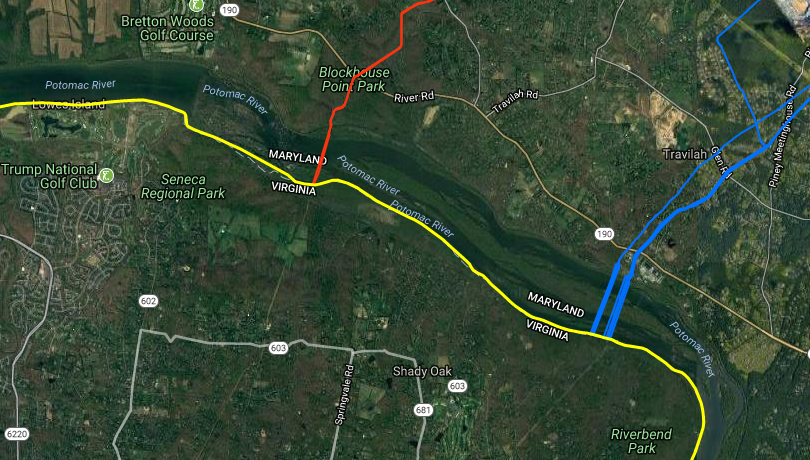
Colonial Pipeline (orange) runs north of Fairfax County, crossing the Potomac River on its path to Linden, NJ
Source: National Pipeline Mapping System, Public Viewer
Tanks farms at the end of pipelines can also be the site of oil spills. The Motiva tank farm on Pickett Road in the City of Fairfax handles 40% of gasoline in the Northern Virginia area. In 1980, 300,000 gallons of gasoline spilled on the surface there, when a pipeline shipment was directed to a small rather than a large tank. The spill forced evacuation of the Comstock subdivision south of the tank farm.19
In 1990, rainstorms brought to the surface some petroleum that had accumulated underground leak from leaking pipes and small overfills of trucks at the tank farm since it was built in 1965. The contaminated groundwater and fumes/oil sheens at the surface caused property values in the nearby Mantua subdivision to nosedive. Star Enterprises (half-owned by Texaco) purchased numerous homes in the neighborhood (it owned 120 houses in 1998, and still owned 31 houses in 2007), and offered financial incentives to homeowners and the community for decades. The strategy worked - Mantua has stayed a high-value neighborhood while the groundwater has been pumped to the surface and the contaminants removed.20
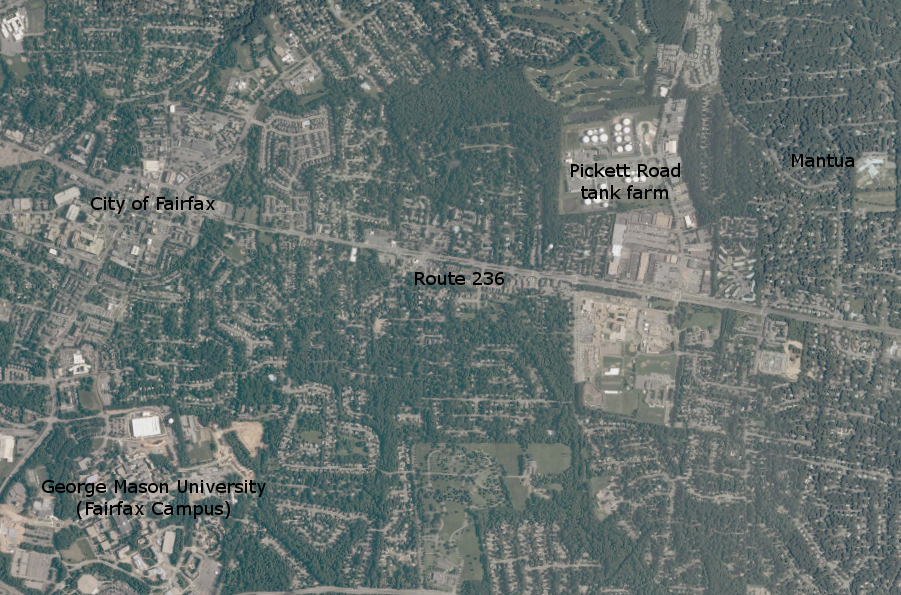
leaking diesel fuel from Pickett Road tank farm contaminated the Mantua neighborhood
Map Source: US Geological Survey (USGS) - Fairfax 7.5x7,5 topographic quadrangle (2011)
Pipelines are cost-effective for shipping large quantities of refined petroleum products to a few destinations, but not to end customers such as gas stations. Except for airports that receive jet fuel directly, most gasoline and distillates such as heating oil finish their journey in a truck.
Pipelines carry refined petroleum to a blending terminal, such as the Motiva terminal on Pickett Road in Fairfax County. After additives are blended with the pipeline product to create different brands of gasoline, tanker trucks transport the finished gasoline from the blending terminal to a gasoline station. Trucks also carry heating oil directly to individual customers.
In 2017, after Hurricane Harvey hit Texas and forced the Colonial Pipeline to stop operating for two weeks, the decline in supply led to a 25% increase of prices at gas stations at the northern end of the pipeline in New York City.
In 2021, the Colonial Pipeline shut down for nearly a week after a ransomware attack by a group of organized cybercriminals on its information technology systems. At the time, the pipeline was transporting 45% of the East Coast's fuel supplies. That percentage had increased after the closure of refineries in Yorktown, Pennsylvania, and other locations on the East Coast had reduced the supply of gasoline, diesel, and jet fuel from those alternative sources. Ships still delivered refined products, but increasing the number of tankers to offset a complete shutdown of the 2.5 million gallons/day shipped via the pipeline would involve at least a two-week delay.
Though supplies in storage tanks were drawn down to continue deliveries in 2021, there was a customer response that exacerbated the problem. Mimicking the hoarding of toilet paper at the start of the COVID-19 pandemic in 2020, people created a spike in demand by filling up all available gas tanks.
In Virginia, Governor Ralph Northam declared a State of Emergency. That authorized fuel truck delivery drivers to work extra-long hours, and banned sellers of gasoline from raising prices to levels which would gouge customers - though one in Richmond raised prices to $6.99/gallon. Panic buying caused half of the gas stations in the state to run out of gas before pipeline operations were restored.21
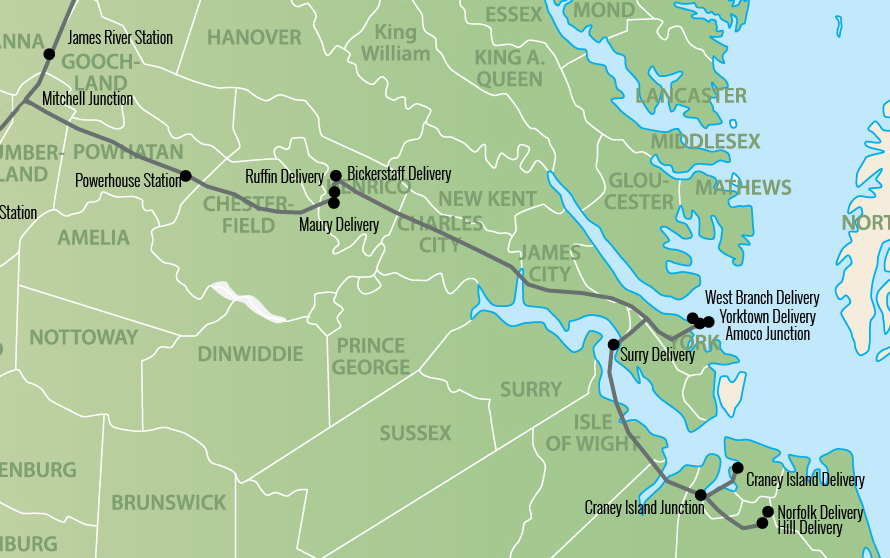
Colonial Pipeline has a spur delivering refined petroleum products to terminals near Richmond and in Hampton Roads
Source: Colonial Pipeline, Colonial Line 25 Project
In contrast, most natural gas is delivered via pipeline all the way to the customer's house or business. There are some exceptions - Liquified Petroleum Gas (LPG) can be shipped in railroad tanker cars and trucks, and compressed propane gas is transported via truck to refill tanks at houses/businesses that are not connected directly to pipelines. In addition, customers with backyard grills handle the last leg of some propane transport, by exchanging propane tanks at hardware and other stores to get refills.
The small quantities of oil that condense at natural gas wells in the Appalachian Plateau rarely justify construction of a pipeline:22
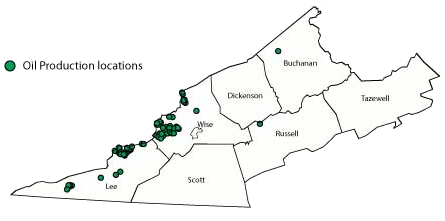
Virginia's crude oil production locations in 2006 included sites where liquids captured at wells drilled primarily for coal bed methane/natural gas
Source: Virginia Department of Mines, Minerals and Energy - Oil
Transport of large quantities oil via railroad is economically viable in areas where pipeline capacity has been reached, or where pipelines do not exist. Railroads now create 80-100 car unit trains to transport low-sulfur Bakken crude oil from North Dakota, or high-sulfur crude oil from western Canada, to refineries near New York City. A single tanker car can carry 30-32,000 gallons of "light" crude oil from North Dakota without exceeding the weight limit of 286,000 pounds/car, but only 25,000 gallons of "heavy" crude oil with a different molecular composition.23
Two unit trains/day are equivalent to a 150,000 barrel/day pipeline. The tanker cars are sent back empty for another load of oil. Railroads could clean each tanker car and transport refined products back west, earning a profit from shipping material in both directions, but the cost of cleaning would exceed the profit and existing distribution systems (including pipelines) already deliver gasoline, kerosene, heating oil, and other refined petroleum products to markets between the East Coast refineries and the North Dakota oil fields.24
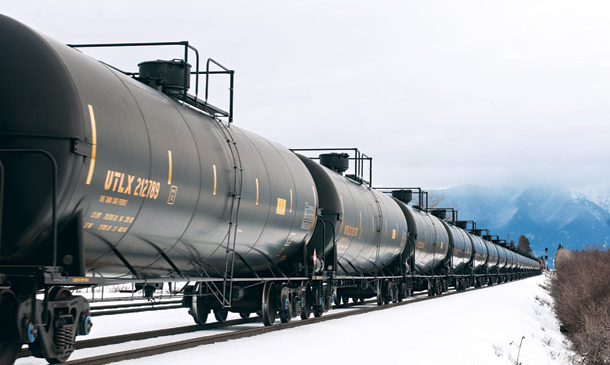
tanker cars in Virginia carry refined petroleum products, but in other states railroads are successfully competing with pipelines to transport crude oil from new fields to refineries
Source: US Department of Transportation, DOT outlines options for enhancing tank car standards
Though the refinery at Yorktown has closed and been removed, there are still crude oil shipments delivered by rail and ship to that destination. The storage and distribution hub at the site of the former refinery was designed to receive two unit trains per day of Bakken crude oil. The 80-100 tanker cars in each unit train create a "rail pipeline," and CSX railroad can deliver 130,000 barrels daily. Up to six million gallons of oil can be stored in various tanks in Yorktown, awaiting re-shipment.25
Plains All American Pipeline, owner of the Yorktown facility, got its local property taxes reduced by 70% in 2018. The company argued in 2018, in an appeal of its property assessment, that it had made a bad investment when it paid $220 million in 2011 for the refinery and tank farm. It said the site was worth only $25 million, not the $234 million in the assessment made by York County.
The county's assessment was based on the cost to replace the storage tanks, pipelines, and other equipment. York County's Board of Equalization agreed with Plains All American Pipeline that a different assessment technique, based on the income generated by the storage operations, should be used instead of the replacement cost approach. The Board of Equalization, after reviewing documents provided by the company, dropped the assessment to $67 million.26
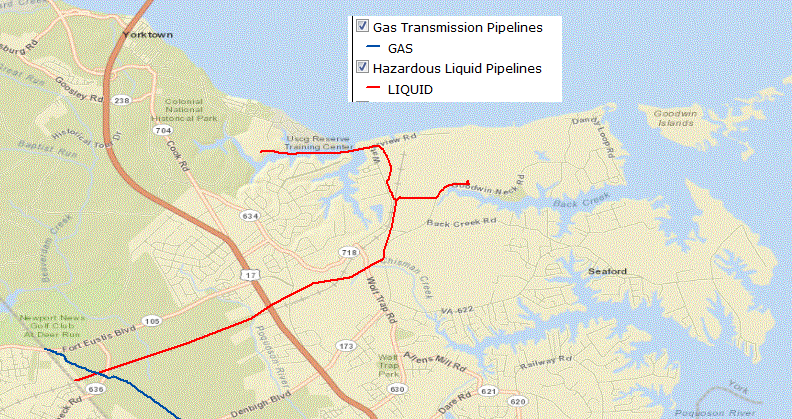
Colonial Pipeline completed a 1-mile extension in 2011 to Yorktown refinery on Goodwin Neck Road
Source: US Department of Transportation, National Pipeline Mapping System
CSX can also transport tanker cars loaded with refined petroleum products such as diesel and gasoline, plus ethanol and biodiesel produced from renewable sources, to Yorktown. From the large storage tanks at that terminal, tankers/barges carry crude oil and other products to refineries near Philadelphia and New York.

CSX oil trains carry crude oil from west-to-east through the middle of Virginia to Yorktown, while tanker cars on the north-to-south route (parallel to the I-95 corridor) carry refined petroleum products
Source: CSX, Crude Oil Network Map
The distinction between ethanol vs. crude vs. refined petroleum products is often confusing to people who live near train tracks. In a 2013 train accident in Quebec, tanker cars carrying crude oil from North Dakota exploded and over 40 people died.
CSX reassured residents in Washington DC that in 2013 only three tank cars loaded with crude were transported by the 7,000 trains that traveled on the CSX rail line going through the city (and across the Potomac River, through Alexandria). That claim may have been accurate for crude oil shipments, but news stories at the time discussing the risks of hazardous materials transport failed to address the number of rail cars loaded with ethanol or refined petroleum products traveling through Alexandria, Fredericksburg, Richmond, etc.27
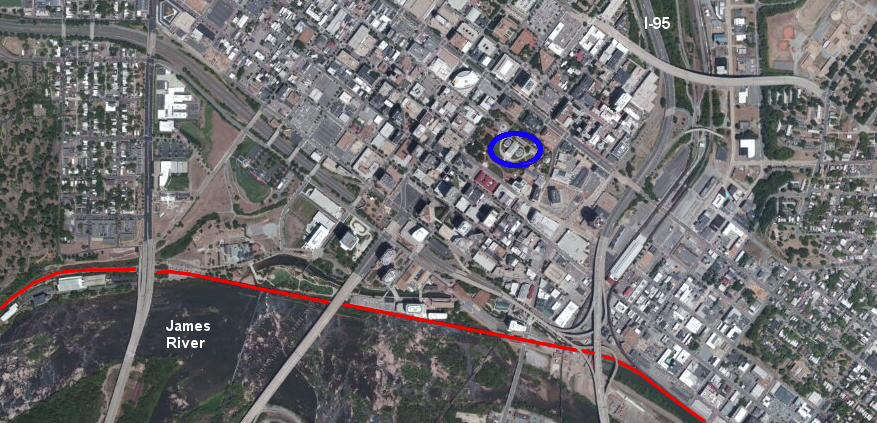
Bakken crude oil is transported by train to Yorktown on the CSX viaduct (red line), one-half mile from the State Capitol in Richmond (blue circle)
Source: ESRI, ArcGIS Online
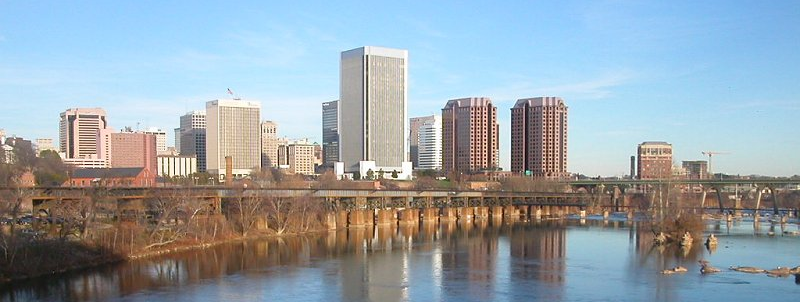
the railroad viaduct was built parallel to the James River in 1901, to move trains away from the commercial center of Richmond
An April, 2014 train accident in Lynchburg resulted in dramatic pictures of tanker cars burning along the city's downtown waterfront along the James River. The crude oil in those cars had come from the Bakken formation in North Dakota. That oil production region had surged due to the success of hydraulic fracturing ("fracking"). The supply exceeded available pipeline capacity, so Bakken crude was shipped by rail to refineries in the Northeastern United States.28
A February, 2015 train accident in West Virginia blocked transport of the oil trains running on the normal CSX route along the James River. Until the tracks were repaired at the accident site, CSX arranged with Norfolk Southern to transport Bakken crude on tracks that parallel the New River, then go through Roanoke, Lynchburg and Petersburg to reconnect with the CSX line.29
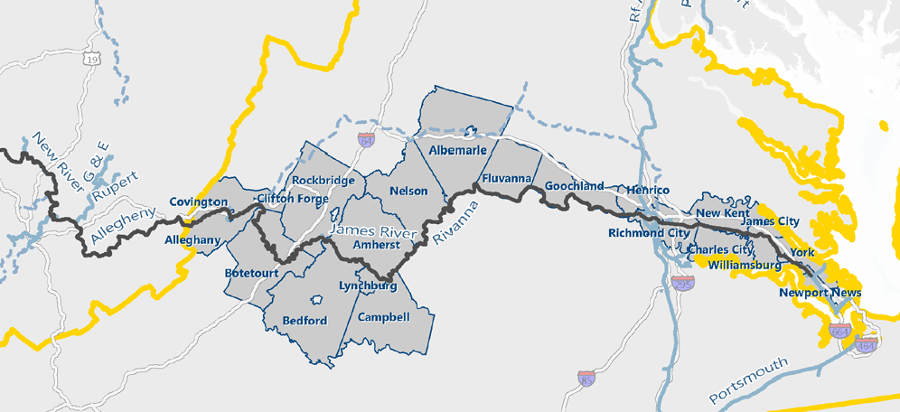
because there in insufficient pipeline capacity to transport oil from the North Dakota Bakken formation to refineries in the Northeast, CSX trains carry crude oil on tracks that parallel the James River to storage facilities at Yorktown
Source: Virginia Department of Emergency Management, First Bakken Crude Oil Shipment Notification Response Package (prepared by CSX)
Biodiesel and ethanol for blending can also be shipped via barge/truck to customers, bypassing the constraints of transporting biofuels in pipelines. There are no ethanol pipelines in Virginia. Ethanol is transported in bulk by rail and truck rather than by pipeline, because the alcohol-based ethanol absorbs water that can rust pipeline equipment. For the same reason, pipelines do not ship finished gasoline, because it contains ethanol.
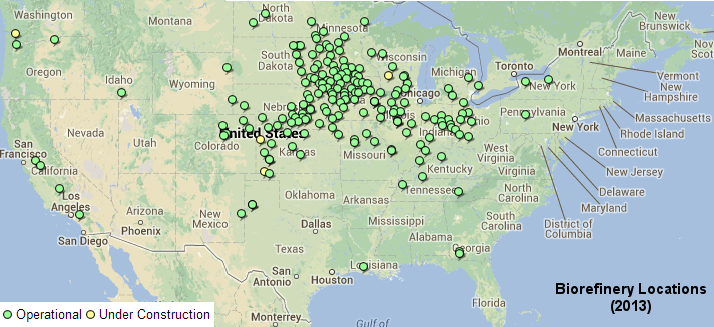
biorefinery locations are concentrated in the Midwest, but most oil pipelines carry crude
south to the Gulf Coast refineries or carry refined products from the Gulf Coast to northeastern customers
Source: Renewable Fuels Association, Biorefinery Locations
Most ethanol is distilled from corn in the middle of the United States, but primary markets are urban areas with Clean Air Act compliance challenges. At rail yards, tanker cars unload ethanol into trucks, which carry it to tank farms with blending terminals. There, ethanol is added to create E-10, E-15, and E-85 mixes, while other additives are blended in to create the specific gasoline formulations sold by brand name retailers such as Exxon, Shell, etc. "Finished" gasoline with specific brand names is then carried by tanker trucks to local gas stations, completing the supply chain.
Why isn't ethanol transported by truck from the Midwest ethanol refineries to Virginia? Transport by rail in 30,000-gallon tank cars costs far less than shipping via 9,000-gallon trucks, each of which requires its own driver - compared to two railroad workers driving a train that can haul 100 tanker cars. As the US Department of Transportation has calculated:30
Pipeline transport of ethanol would be cheaper than rail transport, but that would require a pipeline dedicated to just ethanol. Crude oil and/or refined petroleum products with different chemical compositions can be shipped in batches via pipeline, but pipeline companies avoid transporting E-10 and E-15 gasoline to minimize the corrosive effects of ethanol. The Central Florida Pipeline is a rare exception, moving ethanol and gasoline in batches across a flat terrain since 2009.31
As noted by the US Energy Information Administration:32
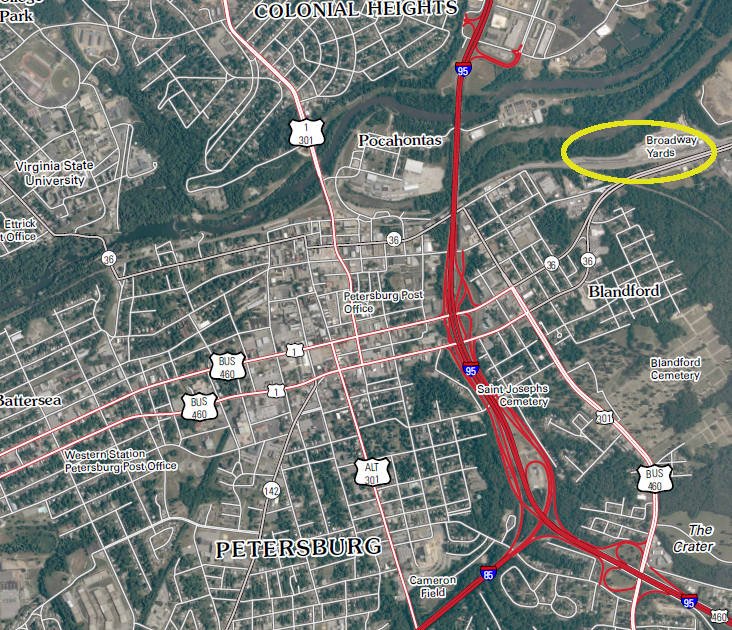
Norfolk Southern has an ethanol rail-to-truck transloading facility in Petersburg at Broadway Yards
Map Source: US Geological Survey (USGS), Petersburg 7.5x7.5 topographic quad (2010)
The Norfolk Southern railroad imports biofuels by train to Thoroughbred Bulk Transfer terminals in Alexandria, Petersburg, and Roanoke. CSX has ethanol terminals in Norfolk, Portsmouth, Chesapeake, Richmond, and Fredericksburg. CSX may also transport ethanol to the storage and distribution hub at the former oil refinery in Yorktown.
CSX announced plans in 2012 to extend its line of ethanol terminals further north to Prince William County. That required building a new facility near the existing Possum Point power plant and the developing Potomac Shores community. As described by CSX:33
Norfolk Southern operates an ethanol transloading terminal in the Van Dorn rail yard in Alexandria, from which trucks carry ethanol to gasoline tank farms in Springfield and in Fairfax City. Alexandria officials object to the ethanol transfer terminal within the city boundaries.
Though Alexandria developed as a transportation hub in the 1800's, today its economy is based on professionals who work in offices, high-end retail, and tourism. The former Potomac Yard, where rail cars were classified and lined up into trains headed to various destinations for almost a century, is being transformed into a mixed-use community with residential developments.34
Industrial operations transferring a flammable, hazardous material from rail to truck are considered by the city to be an inappropriate use near communities such as such as Cameron Station. Tanker trucks carrying ethanol through city streets are considered safety risks and traffic impediments. As noted in Alexandria's lawsuit attempting to regulate activities at the Van Dorn ethanol transfer facility:35
The Federal Surface Transportation Board and the a Federal judge ruled in 2009 that local land use controls and truck-hauling permits are trumped by Federal laws for interstate rail operations, so Alexandria could not require Norfolk Southern to obtain city permits for operating the ethanol transfer facility at the Van Dorn rail yard. However, state air quality permits would be required for the railroad to increase transfer capacity from 14 to 30 tanker cars, as Norfolk Southern proposed in May 2013.36
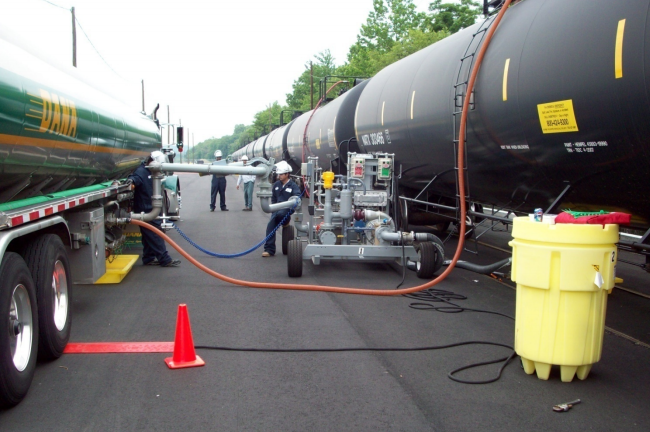
transferring ethanol from rail car to tanker truck, for transport to a tank farm where ethanol will be blended with gasoline for final shipment by truck to gas stations
Map Source: City of Alexandria, Ethanol Transloading
(presentation to City Council, May 27, 2008)
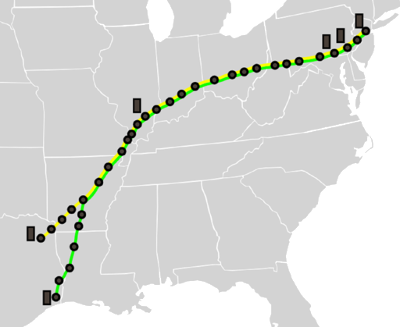
the Big Inch and Little Inch pipelines built in World War II did not go through Virginia
Source: Wikipedia, Big Inch
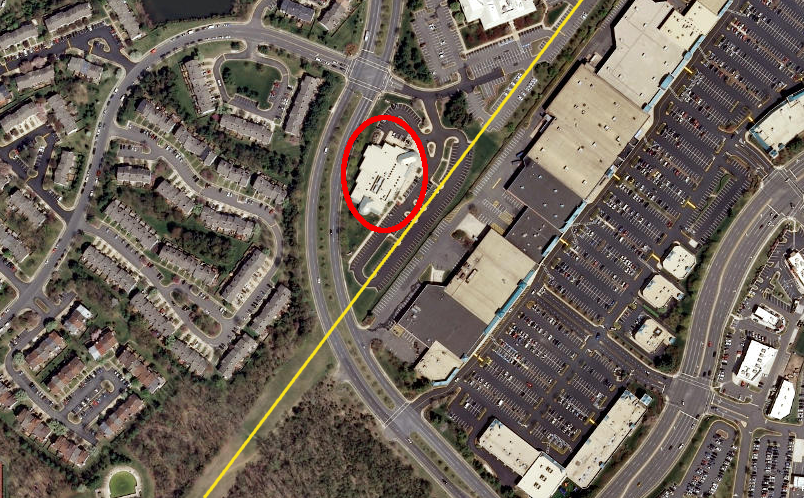
fire drills at the Bull Run Regional Library in Prince William County include training to leave the building (red circle), but not to gather in the parking lot on top of the Colonial pipeline (yellow line)
Source: ESRI, ArcGIS Online